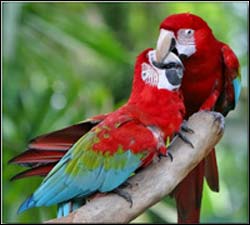
ASU researchers finds novel chemistry at work to provide parrot’s vibrant red colors

Parrots, long a favorite pet animal, are attractive to owners because of their vibrant colors. But those colors may mean more to parrots than what meets the eye.
For more than a century, biochemists have known that parrots use an unusual set of pigments to produce their rainbow of plumage colors, but their biochemical identity has remained elusive. Now, an Arizona State University researcher has uncovered the chemistry behind the colors of parrots, describing on a molecular level what is responsible for their bright red feathers.
The work casts a new light on what is chemically responsible for the colors of birds, and defies previous assumptions and explanations for color variations in parrots, said Kevin McGraw, an assistant professor in ASU’s School of Life Sciences. “Evolutionary biologists have not really thought hard about parrot coloration,” said McGraw. “This research is exposing a whole new world of color communication in parrots and the potential physiological and biochemical roles of the new molecules we found in our work.”
Details of the work are in a paper, “Distribution of unique red feather pigments in parrots,” by McGraw and Mary Nogare, a parrot fancier from Snoqualmie, Wash., published in the Feb. 16, 2005 issue of the journal Biology Letters. Animals, like birds and fishes, commonly use biochromes like carotenoids to acquire red, orange or yellow coloration, but McGraw and Nogare found that these compounds are not responsible for the red colors found in the parrot species they sampled.
The researchers used a chemical analysis technique called high-performance liquid chromatography to survey the pigments present in red parrot feathers. McGraw and Nogare collected and analyzed samples from 44 parrot species that have red feathers. Overall, there are some 350 species of parrots, 80 percent of which have red in their plumage.
They found a suite of five molecules, called polyenal lipochromes (or psittacofulvins), that color parrot plumage red in all of the species studied. “We’ve uncovered a system where all red parrots use the same set of molecules to color themselves,” McGraw said. “It is a unique pigment found nowhere else in the world. We are fascinated at how parrots are able to do this. “The fact that there is a single set of molecules unique to and widespread among parrots, suggests that it is a pretty important evolutionary novelty, and one we should carefully consider when we think about why parrots are so strikingly colorful,” McGraw said.
McGraw has been studying the colors of birds for seven years. He first became interested in the behavioral significance of bird colors as a form of visual communication within a species (e.g. to denote status or attractiveness). As he studied these aspects, he wanted to understand more about what makes the colors of the birds possible, and then focused on “deconstructing the color into its component parts.”
McGraw said an interesting aspect of the five polyenal lipochromes that provide the red in parrots, is that the pigment is found only in the bird’s feathers and nowhere else in the body of the bird, indicating that parrots manufacture these molecules internally and directly at the maturing follicles of the growing, colorful plumage.
In addition, these pigments may play a valuable role in maintaining the health of parrots. McGraw cites an independent study on the parrot pigments that suggests that they can act as anti-oxidants to quench free radicals and potentially protect cells and tissues in the body from oxidative damage.
Now, McGraw says, he’s interested in learning more about the connection between the red colors and anti-oxidants within and among parrot species, as well as “to specifically explore the balance of naturally and sexually selected costs and benefits to becoming colorful.
“Parrots are unusual among birds, in that they almost without exception display fantastic colors but exhibit very little variation in color within a species – at least in colors visible to us. Parrots in general may not be using color in the classic cases of mate choice or competitive ability,” he said. “Exactly why they are so uniformly colored remains an interesting mystery to us – one we want to investigate.”
“There is a sea of colors in birds,” he added. “Our goal is to learn why there is such a diversity from an evolutionary standpoint.”














